In this article, I’ve included my recipe for the ultimate homemade New York style pizza. I’ll go through every step in great detail, leaving no stone unturned (or pizza unturned should I say)!
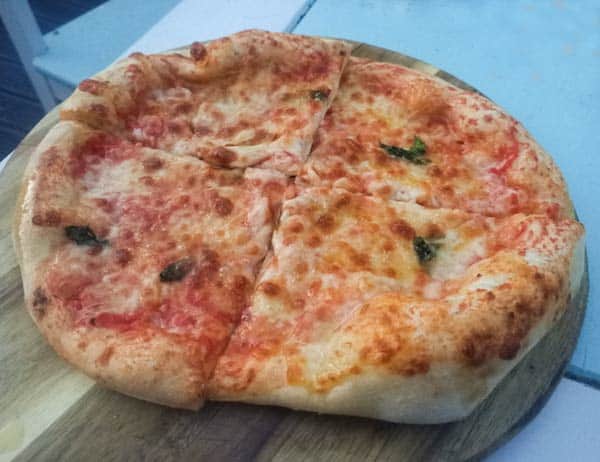
Don’t worry, making New York pizza at home isn’t difficult. It takes practice but it’s fun, rewarding, and tastes amazing!
In this article, I’ll first discuss what makes a New York pizza and why it’s so good. Then I’ll discuss the specific methods and ingredients used to achieve the best New York pizza.
To learn more about the New York style of pizza and it’s origins, check out my article on what is New York pizza here.
At the bottom of this page, I’ve included my recipe for the perfect New York style pizza. If you like, you can click here to skip to the recipe.
But first, let’s go over what makes the New York pizza so good. Understanding how the New York pizza is different should go a long way to helping us recreate it.
In my view, I think quality ingredients along with the skills of the pizza chef is what makes NYC pizza so good. The quality of the dough is one the most important factors. Making quality dough takes practice, as does shaping pizza by hand, and cooking the pizza to perfection.

The fact that there is a strong tradition of pizza making within New York surely helps. And given that there are so many pizzarias within the city, it probably helps to create some healthy competition.
But the good news is that you can learn to make incredible NYC pizza at home. It really isn’t that difficult, it just takes practise, and attention to detail. But it’s really fun and very rewarding!

Even better still, homemade pizza tastes incredible!
If there’s one secret to NYC pizza that I’ve learned over time, it’s about the fermentation of the dough, or the “prove” as it’s know. This is where the yeast works it’s magic, producing an incredible taste and texture in the dough.

For me, the real “secret” is to prove the dough for longer. The best pizzas use freshly made dough which has been proved for usually at least 8 hours, but usually 24 hours, and sometimes even longer.
The longer the proof, the better the flavour and texture in the dough (up to around 48 hours). It also makes for a more forgiving dough that is easy to work with. This allows the pizza maker (that’s you!) to make the best pizza possible every time.

To achieve this slow fermentation, it’s important to use less yeast. This ensures that the dough doesn’t overprove.
Feel free to check out my yeast calculator here if you are interested in devising your own recipes (like some sort of mad scientist)!

The ingredients in the dough are also very important, particularly the flour.
Typically, New York pizzerias use a strong white bread flour, which is high in protein. The high protein helps in gluten development, producing a strong and stretchy dough. But not all pizzerias use the same type of flour.

While Neapolitan pizza calls for an ultra-fine Italian 00 flour, New York pizza typically uses a slightly coaser flour. This is largely due to the lower temperature that the pizza is cooked at.
Coarser flours (that are also high in protein), tend to produce crispier crusts and more browning at lower temperatures. This is partly due to them having a higher sugar content.

For this reason, New York pizzerias tend to favour the coarser Italian type 0 or type 1 flour, or strong white bread flour. In practice, most high protein flours can be used for New York style pizza. They will tend to produce a strong dough which will usually crisp and brown better.
In contrast, 00 flour tends to work better at higher temperatures, such as those used for Neapolitan pizza. It allows for a crispy crust with a soft interior.

But generally, a high gluten flour is used, since this can produce strong and stretchy dough, perfect for pizza shaping.
To summarise, for New York style pizza, I recommend a strong white bread flour with a protein content of between 13% – 14%. The protein content is usually listed on the packaging. It is usually represented as a quantity of protein per 100g. So 13% – 14% is often listed as 13g or 14g (per 100g).
Another important consideration is the hydration of the dough. Or in other words, the amount of water in the dough. This can have a huge effect on the consistency of the dough.
NY pizza dough hydration is typically higher than Italian Neapolitan pizza dough, at around 60% – 65%. This is largely due to the fact that a coarser, and often higher protein, flour is used.

The hydration basically refers to how much water is in the dough, measured as a percentage of the flour. For example, if a pizza contained 200g flour and 100g water (300g dough ball), this would be 50% hydration. Check out my article on pizza dough hydration here for more information.
Notice that the actual percentage of water in the dough is 33%. This can be a bit confusing but basically, the water is measured as a percentage of the flour, not the total dough. Therefore the hydration is 50%, not 33%.

You can check out my article on pizza dough hydration here if you haven’t already seen it.
Neapolitan pizza is usually somewhere in the 56% – 60% hydration range as opposed to the 60% – 65% hydration range for NY pizza dough. The different flours absorb water differently, with Italian 00 flour requiring less water than say, strong bread flour.
Many people assume that because NY pizza has a higher hydration that it is a wetter dough but this is not necessarliy true. Even though the hydrations are different, the consistencies are quite similar. It is simply the flour which requires different hydrations.

For a strong white bread flour, I would recommend starting at 60% hydration. From there, you can adjust the recipe as required, but I typically find this to be close to optimal for most strong bread flours.
There seems to be a trend these days towards high hydration doughs, of around 70% or higher. In my opinion, this should be avoided unless you are an expert. High hydration doughs are difficult to shape and it’s easy to end up with a thick base, which is not typical of the New York style.
Next, let’s look at putting some sugar in the dough!
Sugar is arguably the most common addition to New York style pizza dough. It is almost never added to Italian pizza dough but it is almost always added to NYC dough.

A lot of people believe that the addition of sugar is required for the yeast to ferment, but this isn’t true. There are plenty of sugars for the yeast within the flour itself.
The sugar is generally added for sweetness and to encourage browning. The improved browning is particularly important for NYC dough, given that it is cooked at a lower temperature when compared to Neapolitan pizza.

Whilst adidng sugar will tend to speed up the fermentation, so would adding more yeast. And in general, longer proves are preferable as they tend to lead to a better texture and improved flavour. So really, there’s no need to add sugar for fermentation.
However, sugar does provide some sweetness, which many people believe is beneficial to the New York style. Traditionally, sugar would probably rarely be used but it is increasingly common today.

In fact, most people would probably consider sugar to be an essential ingredient in NYC pizza dough.
Aside from the flavour though, the main reason for adding sugar is to encourage browning.
In general, the best New York pizzarias tend to use up to 2% sugar compared to the weight of flour (baker’s percentage). This should be enough to encourage browning and add a little sweetness, without overpowering the dough.
Feel free to check out my article on baker’s percentage here if you want to learn more about percentages.

At the end of the day, there’s no right answer, so feel free to experiment with your dough to see what you prefer and what works best for your oven. But personally, I would recommend between 1% – 2% sugar. Any less than 2% and it won’t impart much flavour, any more than 3% and it may become too sweet.
Olive oil is often added to New York pizza dough. The main reason for this is to assist with the browning of the crust, the same reason why sugar is added to the dough.

With Neapolitan pizza in contrast, the olive oil can lead to burning. This is because that style of pizza is cooked at a much higher temperature, and is also cooked with open flames which naturally provide some charring.
Olive oil does provide some flavour to the pizza base but it is only used in very small quantities so the flavour is not significant. The main benefit to using olive oil in the dough is to encourage browning on the pizza base and the crusts, similar to adding sugar.

The use of olive oil can also help with handling, especially with wetter doughs. Many pizza chefs choose to use olive oil instead of flour to assist in the balling of dough, since it doesn’t dry out the dough.
In general, Extra Virgin Olive Oil is considered the best oil for pizza dough, due to it’s rich and deep flavour. However, since the oil is cooked in the dough, the flavour difference is not as noticeable as with uncooked oil.

For this reason, many pizzarias chose to save some money by using regular olive oil in their dough. For making pizza at home, use whichever you prefer. You could even run an experiment to see if you can tell the difference!
As with sugar, the best New York pizzarias tend to use up to around 2% olive oil compared to the weight of flour (baker’s percentage). This should be enough oil to encourage browning and add a little flavour, without overpowering the dough.
You can check out my article on baker’s percentage here to find out more about dough percentages.

But all pizzarias use a different amount and some don’t use any at all. It comes down to personal preference, as well as the oven you are using.
For cooking at low temperatures (around 260C/500F or below) in a home oven, I would recommend adding both sugar and olive oil.

Adding both sugar and oil should help to get some nice browning. If you find you’re getting too much browning, I would then omit the olive oil and just stick to adding sugar.
Below, I’ve included my recipe for the perfect New York style pizza at home. It’s really quite easy to make, it just takes a bit of practice.
Don’t be put off by the long prove in the recipe. Aside from a bit more preperation, this doesn’t take any more work. It tends to lead to a nicer dough which is also more forgiving and easier to work with (especially when shaping).

If you’ve made my Neapolitan pizza recipe before, then you should find this recipe fairly straightforward. The methods used are very similar, the main difference is in the ingredients used.
Also, I recommend checking out my pizza school series here if you haven’t already. There are articles (with videos) explaining practically every method used in pizza making.

The first part is on mixing the dough by hand. I recommend using your hands as much as possible as this should help to develop your feel for the dough. Kneading by hand is also really easy. But you can use a dough mixer on a low setting for the kneading though if you prefer.
With that being said, let’s get into my recipe for New York style pizza at home!
How to make the best New York pizza
This recipe makes an authentic New York style pizza which you can cook in your regular
Makes 4 x 12 inch pizzas.
Use Strong White Bread Flour (around 13g-14g protein).
For cooking in a regular domestic oven:
For cooking in a pizza oven:
Not all the following utensils are required but these are what I use and they tend to make the process much easier.
Any large bowl could be used for mixing the dough but I like using the metal ones since they’re lightweight, stackable, and easy to clean.
Click here to check out metal mixing bowls like the ones I have on Amazon.

These are affordable, easy to use, and precise (accurate to 1g). I don't recommend using cups as measurements as they are inprecise.
Click here to take a look at the type of digital scales I use on Amazon.

These kitchen scales are accurate to 0.01g and are perfect for measuring the tiny amounts of yeast needed for long proves.

Pizza proofing boxes are an excellent investment. They are airtight and they make taking the dough out for shaping very easy.

An infrared thermometer allows you to instantly check the temperature of the stone, ensuring it is within the ideal range.
Click here to check out a pizza peel similar to the one I use on Amazon.
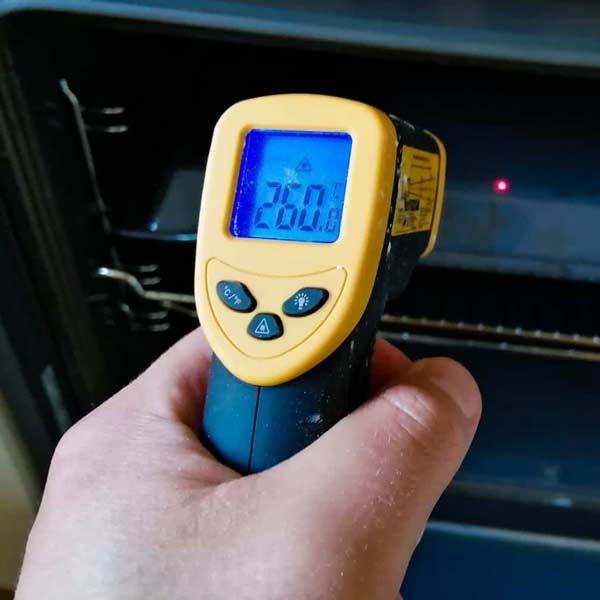
A 12 inch peel is ideal for Neapolitan pizza and makes loading and removing your pizza from the oven really easy.
Click here to check out a pizza peel similar to the one I use on Amazon.

A turning peel is designed for rotating the pizza during cooking. If you're using a pizza oven it should lead to a superior and more even cook.
Click here to check out a pizza peel similar to the one I use on Amazon.

A pizza oven is guarenteed to take your pizzas to the next level. I have an Ooni Karu 16 which reaches 500C/930F and cooks pizza in as little as 60 seconds! A regular oven simply cannot match the cook of a pizza oven. I love my Ooni!

Tips:


Check out my article (with a video) on mixing by hand here

The dough should look something like this when “roughly” mixed

Check out my article (with a video) on kneading by hand here
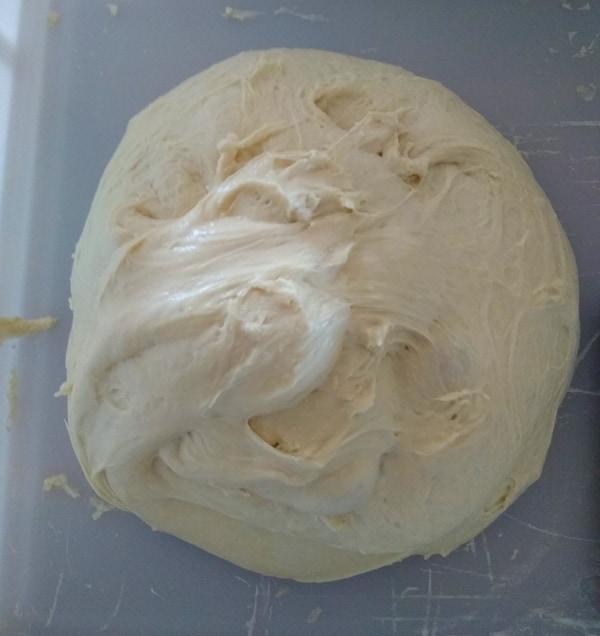
You can prove the dough in a bowl or if you have one, a pizza proofing box. I’ve included a link to one of these boxes on Amazon below.
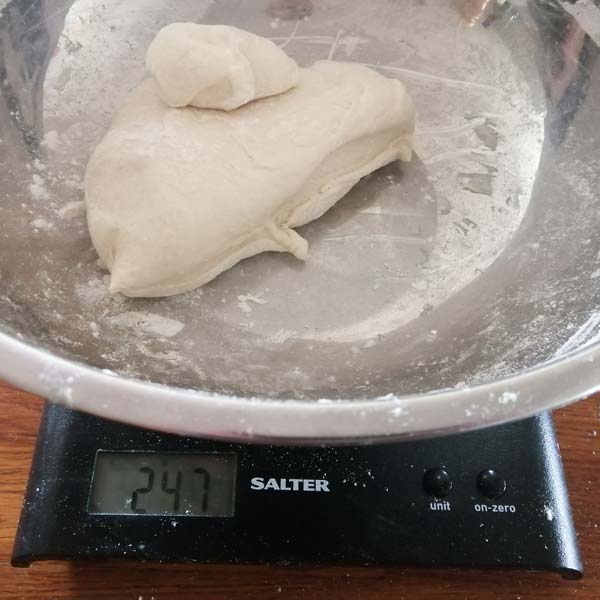
Digital scales are ideal for weighing the dough. I’ve added a link to some on Amazon below if you want to check them out.
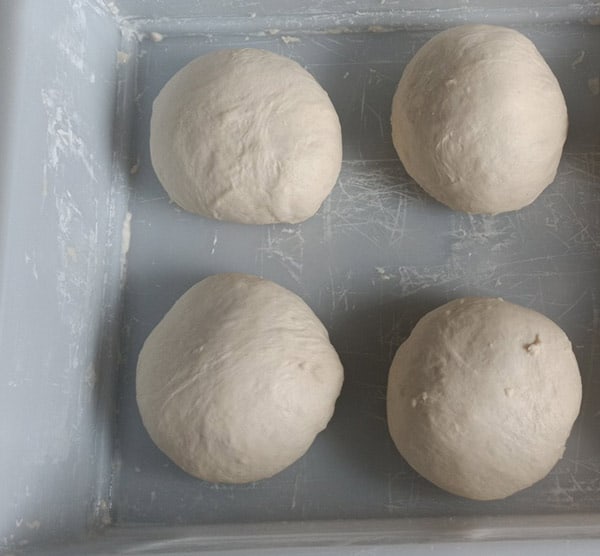
This is where a pizza proofing box (Amazon link below) comes into it’s own
Tips:


Blending the tomatoes is all you need to do, no need for cooking

Don’t forget to generously season your sauce
Tips:

Directions for shaping & cooking:

With a regular home oven, it’s probably a good idea to turn the oven to full temperature. I’ve provided a link to a laser thermometer on Amazon below.

A wallpaper scraper is really useful for removing the dough – one that hasn’t been used on wallpaper!




Check out my article (with a video) on shaping here

We’re looking for an even round shape but it doesn’t have to be perfect.
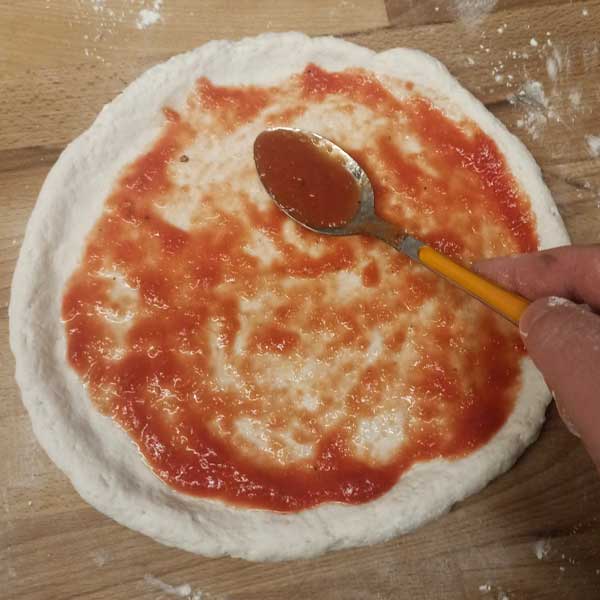

A pizza peel is hugely helpful for transferring the pizza to the oven. I’ve provided a link to a 12 inch pizza peel (perfect for this recipe) on Amazon below.

Using a pizza stone or pizza steel is ideal, such as the one on Amazon below.

My Ooni pizza oven cooks Neapolitan style pizza in just 60 – 90 seconds! But for New York pizza, a lower temperature is required. Below is a link to my specific pizza oven – The Ooni Karu 16 Multi-Fuel Pizza Oven.

Delicious New York pizza!

These are generally inexpensive and highly accurate. I have provided a link to some on Amazon below.

This is 0.3g of yeast on a regular teaspoon

I absolutely love New York style pizza, and all pizza for that matter! Most of this website to date has been about Neapolitan style pizza. However, NYC pizza can be equally as delicious!
If you haven’t already, I would urge you to check out my pizza school series. It covers all the techniques you’ll need for making amazing pizza. Although I make Neapolitan pizza in the videos, the techniques are interchangeable.

The good news is that once you know how to make one type of pizza, you should have no problem making the other.
As usual, if you have any questions, feel free to leave me a comment below. I’ll try to get back to you as soon as I can.

I’m Tom Rothwell and I’m super passionate about all kinds of homemade pizza! In the last few years I've been on a quest to find the perfect pizza. Now I'm sharing what I've found out with the world!

If you're interested in hiring me for your event in the UK, feel free to check out my website with the link below.
Pizza Catering

I often get asked what type of oven I use for my pizzas. Well, I use a pizza oven made by a company called Ooni.
The range of pizza ovens that Ooni offers is just brilliant. They cover all bases, and all price points. There's affordable and portable models such as the Fyra 12 Pizza Oven and then there's state-of-the-art models such as the Karu 16 Pizza Oven pictured below.
In all honesty, I would say that the oven makes a huge difference. If you're looking to make authentic Italian pizza, a pizza oven is a must.
By clicking the link below and purchasing from Ooni, you would be supporting this website. I've been using their ovens for a long time now and I wouldn't recommend them if I didn't believe in their products.
Time to make some amazing pizza!

I’m Tom Rothwell and I’m super passionate about all kinds of homemade pizza! In the last few years I've been on a quest to find the perfect pizza. Now I'm sharing what I've found out with the world!

If you're interested in hiring me for your event in the UK, feel free to check out my website with the link below.
Pizza Catering